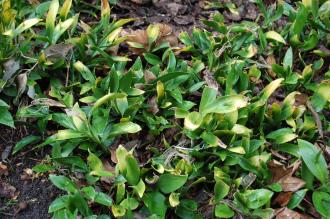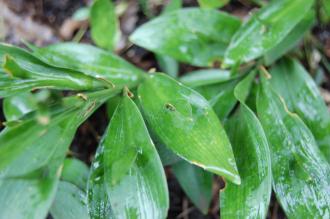
Ruscus hypophyllum (09/02/2013, Kew Gardens, London)
Position: Full sun to shade
Flowering period: Spring
Soil: Moist, well drained
Eventual Height: 40cm
Eventual Spread: 70cm
Hardiness: 9a – 10b
Family: Asparagaceae
Ruscus hypophyllum is a slow growing, evergreen spreading shrub. Its dark green leaves (which are actually flattened stems) are lanceolate with entire margins, up to 10cm long and 4cm wide. At the center of this ‘leaf’ a small dark green appendage is present, this is the true leaf. Its small white to pale blue flowers appear at the true leaf axil. Its red fruit is a berry and up to 15mm across, this is rarely produced. Its roots are rhizomes which aids its spread.
Ruscus hypophyllum, commonly known as Mouse Thorn, Spineless Butchers Broom and Horse Tongue Lily, is native to western Mediterranean.
The etymological root of the binomial name Ruscus is from the Latin name for this plant Ruscum. Hypophyllum is derived from the Greek hypo meaning ‘under’ and phyllon meaning ‘leaf’.
The landscape architect may find Ruscus hypophyllum useful as an effective evergreen, low growing ground cover plant, particularly in a woodland setting. Once established this plant will tolerate periods of drought.
Ecologically, Ruscus hypophyllum berries are attractive to some birds and mammals.

Ruscus hypophyllum Leaf (09/02/2013, Kew Gardens, London)
Ruscus hypophyllum prefers moist, fertile, well-drained soils. It tolerates most pH of soil.
Ruscus hypophyllum requires little maintenance.

